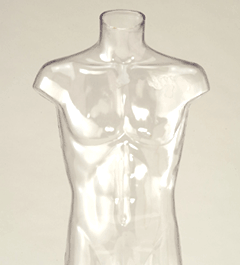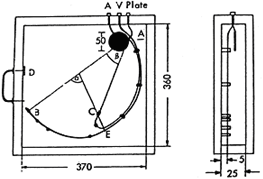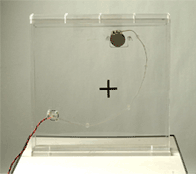Research and Development Menu (Tap to Display Menu)
Pacemaker Live Device Testing
Using human phantoms that simulate the human body and actual pacemakers, we evaluate the protective effectiveness of electromagnetic shielding products. *These are not test results for all devices.
| Human Phantom | Irnich Phantom | Pacemaker Settings | Malfunction Criteria | Measurement System & Simulated ECG Generator |
Human Phantom
The human phantom is a half-body hollow acrylic model that simulates the standard body type of a Japanese male, filled with 0.18% saline solution to electromagnetically simulate human tissue (Photo 1). The pacemaker unit and pacing lead are installed below the left clavicle of the phantom. The lead configuration simulates implantation into the ventricular electrode.

Photo 1: Human Phantom
Irnich Phantom
A biological model (Figure 1) devised by Werner Irnich, this consists of a rectangular container with the dimensions shown in the figure, filled with 0.18% saline to simulate human tissue electromagnetically.


Reference: Irnich, W.: Interference in Pacemakers. PACE, Vol.7, November-December 1984, Part I, pp.1029-1048.
Pacemaker Settings
All pacemakers were set to 50 ppm, operating in VVI mode with unipolar pacing. Sensitivity was set to the maximum allowable value for each device, and the refractory period to the shortest allowable value. These settings represent conditions most likely to induce malfunction.
Malfunction Criteria
Malfunction is deemed to have occurred if any of the following is observed:
- 1. When no simulated heartbeat is input, and although the heart is stopped and pacing is needed, the pacemaker mistakes electromagnetic noise for a heartbeat and stops functioning.
- 2. When a simulated heartbeat is input, but electromagnetic noise causes the pacemaker to miss the signal, resulting in unnecessary pacing even though the heart is functioning.
Measurement System & Simulated ECG Generator
A probe was attached to the tip of the pacing lead and connected to the measuring device via cable. This setup was used to detect pacing pulses and input simulated ECG signals (Figure 2). The NR-2000 data logger by KEYENCE was used as the measurement device. The simulated ECG waveform input from the signal generator was a sine-squared waveform with an amplitude approximately twice the minimum threshold at which the pacemaker responds.

Figure 1: Connection of Human Phantom and Measurement Equipment





